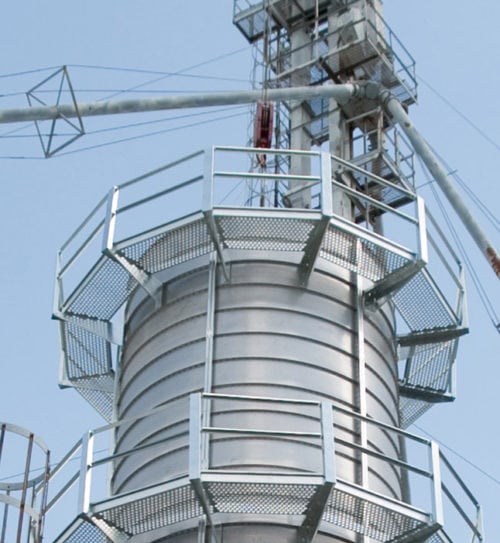For many industrial companies, work platforms serve as a convenient, efficient way to maximize space. While many businesses use traditional work platforms such as steel mezzanines when building industrial structures, safety grating can be an ideal alternative, offering better protection and further enhancing safety. At Metalex, our safety grating features expanded metal to help prevent slips and falls in the workplace, reliably protecting employees, equipment, and facilities at large across a wide range of industries.
Safety Grating in the Communications Industry
 With the ongoing surge in electronic communications, more and more telecom companies are turning to safety grating for use in the construction of communication towers.
With the ongoing surge in electronic communications, more and more telecom companies are turning to safety grating for use in the construction of communication towers.
For example, safety grating might be used on the ice bridges of communication towers to protect cables. A tower’s ice bridge sits where the tower’s cables bend horizontally to go down into the equipment platform. Due to its precarious location and the heavy foot traffic involved, ice bridges can benefit greatly from safety grating — especially when used for stair treads and non-slip ladder rungs and catwalks.
Though safety grating is ideal for all types of industrial towers, it’s especially well-suited to communication towers, since it can hold up the extreme temperatures and harsh environments involved. At Metalex, we offer safety grating constructed from top-quality metals that can withstand extreme cold and other outdoor conditions; aluminum, stainless steel, and cold-rolled and hot-rolled steel are popular options. (While hot-rolled steel and cold-rolled steel often need additional pulse treatments or pulse galvanization, aluminum does not.) These metals’ resistance to extreme temperatures makes safety grating ideal for stair treads, in particular.
Lightweight and allowing for easy installation, safety grating is also well-suited to non-slip ladder rungs and catwalks between towers. Featuring enhanced safety features, safety grating reduces the risk of slips and falls, ensuring workers’ safety once they’re in the air moving between towers. In fact, builders can often incorporate safety grating from the ground up in their tower construction. And, allowing for great versatility, safety grating be installed as non-slip stair tread and extend all the way up to the tower’s equipment platform, providing workers with a safe space to work while elevated.
Though individual communication towers do not require a great deal of safety grating, there’s a lot of opportunity in the market as communication towers continue to grow in number.
Types of Communication Towers
Currently, the industry classifies communication towers based on three criteria: 1) structural action, or how the tower is built, 2) the cross section or shape of the tower’s beams (e.g., hexagonal, square, triangular, or polygonal), and 3) the tower’s materials, particularly those used for the tower’s angular or tubular bracings, as well as the surface the tower stands on. In addition, there are four main types of communication towers — monopoles, self-supporting structures, stealth towers, and lattice towers — each offering unique structural characteristics and benefits.
Monopoles are 100–200 feet in height and feature a single-pole design. These towers generally provide cellular and personal communications services. As freestanding structures, they are often built as cylinders or with multiple sides, and they are sometimes even placed on rooftops. Their construction is unique in that the largest diameter is at the bottom, with the rungs consecutively decreasing in size as they go up.
Self-supporting towers are really large guide towers anywhere from 200 to 2,000 feet in height. These towers keep communication cables separate from the structure, so the tower can withstand high winds and extremely high elevations. The strongest of all towers, they are also the most expensive to build due to their large size and material needs. Self-supporting towers are most often used for television, radio, paging services, and cellular services.
Stealth towers have their components stored within a building, so the tower itself is not visible. For example, from the outside, you may just see a large clock, but inside the clock is an unseen antenna collecting data.
Lattice towers are also standalone, freestanding structures. These towers feature a tapered triangle shape, starting at the base and narrowing toward the top. Safety grating is ideal for lattice towers, as they have an identifiable work surface and workers are able to climb up either the inside or outside of the tower. In addition, lattice towers contain individual sections that each contain a maintenance area. On the bottom of these maintenance areas, Metalex’s expanded metal, or mesh, can be extremely useful in providing workers a secure, safe place to stand on while performing their duties.
Metalex offers a wide selection of products to fit any tower’s specific needs. We focus on providing optimal product versatility, and are proud to offer an extensive selection of pattern variations and designs, as well as a range of ferrous and non-ferrous material options. Click the links below to learn more about our safety grating offerings.
Star Deck
Learn More
Our skilled team has more than five decades of collective experience working with expanded metal grating, and can lend their expertise to help you determine which expended metal product best suits your project’s particular needs. To learn more, download our free eBook, “The Benefits of Safety Grating,” or contact us today to speak with one of our product experts.








Comments are closed